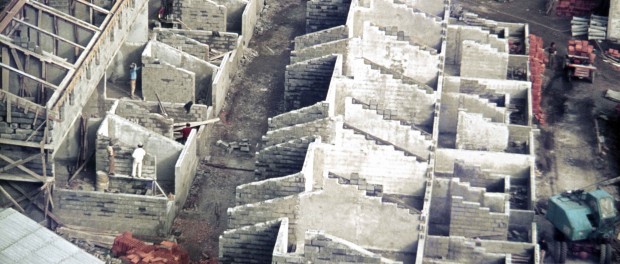The SAAL Process at the CCA: Architecture, urban planning and community
 View of construction of the Antas neighbourhood, Porto, Portugal
1975
Photo courtesy of Alexandre Alves Costa
© Alexandre Alves Costa
View of construction of the Antas neighbourhood, Porto, Portugal
1975
Photo courtesy of Alexandre Alves Costa
© Alexandre Alves Costa
Delfim Sardo, curator of The SAAL Process: Housing in Portugal 1974-76, took me and a handful of other participants on a tour of the exhibition at the CCA, which includes photography, video, text, sketches and blueprints, as well as detailed models of the featured neighbourhoods.
As we began the tour, Sardo explained, “There’s not one SAAL, but many SAAL processes.” The CCA is spotlighting ten of these unique housing projects, out of the 170 Sardo described tens of thousands of families were involved in.

The SAAL Process: Housing in Portugal 1974–76 , installation view of the exhibition at the Canadian Centre for Architecture, May 2015. © CCA, Montréal.
The SAAL process, Serviço Ambulatório de Apoio Local or Local Ambulatory Support Service, began in 1974 after the Portuguese revolution. Sardo expressed how Portugal had to face the problems of the fallen dictatorship, namely the poor living conditions for the working class. There was a need to build houses and deal with the “islands” of slums within the historical centres of major cities, like Porto and Lisbon.
SAAL offered a “technical brigade” composed of architects, lawyers and social workers to these slum associations and groups in order to help them design new neighbourhoods. These brigades invested enormous amounts of work and time figuring out how to occupy what Sardo described as “empty urban spaces.” Even though these projects were not always completed or built at all, it raised important questions about community and social responsibility.

The SAAL Process: Housing in Portugal 1974–76 , installation view of the exhibition at the Canadian Centre for Architecture, May 2015. © CCA, Montréal.
Sardo explained how “the vernacular community” was encouraged to add elements and collaborate with the technical brigades. In one case, plans for a public launderette were challenged because the locals wanted to keep their outdoor sinks, where they would chat amongst themselves. Another video shows how a community gathered together to literally carry an entire house away from where new developments would be built, so that the family could continue to live in the home they wanted to keep.
According to Sardo, despite the failure of most SAAL projects, “people who felt like social diseases,” outcasted and powerless, “took situations into their own hands.” They were able to have influence and power. SAAL also allowed architects to see the social responsibility of their profession.
It was incredibly interesting to see how the SAAL process could be translated into an exhibition touching on so many relevant topics beyond architecture. It was a poetic and insightful experience.
If you want to check it out for yourself, The SAAL Process: Housing in Portugal 1974-76 will be on display at the CCA until October 4.





